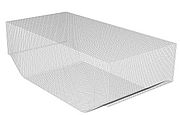Difference between revisions of "Sig Turbulence / Flow over Periodic Hills"
(→Simulation details) |
(→Motivation) |
||
| Line 3: | Line 3: | ||
== Motivation == | == Motivation == | ||
| − | The flow over bodies with massive separation constitutes an important area of applications for LES. In many geometrie we can find this kind of flow like the 2D backward-facing step, the asymmetric diffuser or the periodic hill. | + | The flow over bodies with massive separation constitutes an important area of applications for LES. In many geometrie we can find this kind of flow like the 2D backward-facing step, the asymmetric diffuser or the periodic hill. We know experimental's data which was made by Almeida et al. [1] but in Mellen and al. [2] et Temmerman et al. [3] we can find that they have an influence of the side wall so the 1995 ERCOFTAC/IAHR workshop have cast a doubt on the true periodicity of the experimental configuration. But we have some data from LES with a good mesh like [[http://cfd.mace.manchester.ac.uk/cgi-bin/cfddb/prpage.cgi?81&LES&database/cases/case81/Case_data&database/cases/case81&cas81_head.html&cas81_desc.html&cas81_meth.html&cas81_data.html&cas81_refs.html&cas81_rsol.html&1&1&1&1&1&unknown]]. Flow over 2D periodic is in fact an experimental configuration with 9 hills. For the computational, we represent this configuration by a channel periodic with two half's hills like on the figure 1. |
| − | + | ||
| − | + | ||
| − | + | ||
| − | + | ||
Revision as of 09:50, 29 May 2009
Olivier Brugiere, Universite Joseph Fourier, Grenoble, France
Contents
1 Motivation
The flow over bodies with massive separation constitutes an important area of applications for LES. In many geometrie we can find this kind of flow like the 2D backward-facing step, the asymmetric diffuser or the periodic hill. We know experimental's data which was made by Almeida et al. [1] but in Mellen and al. [2] et Temmerman et al. [3] we can find that they have an influence of the side wall so the 1995 ERCOFTAC/IAHR workshop have cast a doubt on the true periodicity of the experimental configuration. But we have some data from LES with a good mesh like [[1]]. Flow over 2D periodic is in fact an experimental configuration with 9 hills. For the computational, we represent this configuration by a channel periodic with two half's hills like on the figure 1.
The probleme of this flow is the separtion bubble which is due to a adverse pressure gradient that's why this is a test case for many subgrid scale models (SGS) and for near-wall low.
2 Testcase description
2.1 Flow configuration
2.1.1 Geometrical Parameters
- Hill's heigh :

- Streamwise distance :

- Normal wall heigh :

- Spanwise distance :

2.1.2 Boundary condition
- Streamwise condition : periodicity
- Spanwise condition : periodicity
- Normal to streamwise : two walls
2.2 Simulation details
We have make the geometry on Gambit Fig 2 and the mesh is composed by  .
.
The aim of my study is testing a posteriori near-wall low. To compare we are running three cases :
- With near-wall low
- With the Spalding Low [4]
- Wiht the Mahart et al. low [5]
3 Numerical results
4 References
[1] Almeida, Durao and Heitor, 1993, Experimental thermal and fluid science, Vol. 7, pp. 87-101.
[2] Mellen, Frohlich, Rodi, 2000, Large Eddy Simulation of the flow over periodic hills, 16th IMACS World Congress , Lausanne.
[3] Temmerman, Leschziner, 2001, Large Eddy Simulation of separated flow in a streamwise periodic channel construction, Int. Symp. on Turbulence and Shear Flow Phenomena, Stockholm, June 27-29.
[4] Spalding, 1961, A single formula for the law of the wall, Jl. Appl. Mech., vol 28, pp. 455-457
[5] Manhart Peller and Brun, 2008, Near-wall scaling for turbulent boundary layers with adverse pressure gradient, Theor. Comput. Fluid Dyn., vol 22 , pp. 243-260.
Back to Sig Turbulence
